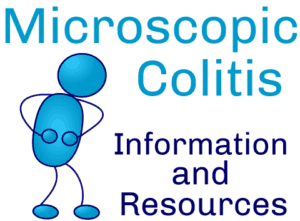When I diagnosed with microscopic colitis, I had a TON of questions. Honestly, I still do, and I’m still learning about this disease every day. I know I can’t answer every possible question here, but hopefully I can cover most of the basics for you to get you started towards understanding this disease.
What Is Microscopic Colitis?
Microscopic colitis (MC) is a type of inflammatory bowel disease (IBD) which affects the inner lining of the colon. It’s caused by an abnormal immune system reaction which leads to inflammation in the various layers colon lining. Microscopic colitis gets its name from the fact it can only be diagnosed by examining tissue from the colon under a microscope. The two most common forms of microscopic colitis are lymphocytic colitis and collagenous colitis.
How Common Is Microscopic Colitis?
For decades, microscopic colitis has been commonly believed by researchers and doctors to be a fairly rare disease affecting a very small portion of the population. This is why there has been less research focused on MC than on other inflammatory bowel diseases such as ulcerative colitis (UC) and Crohn’s disease. However, some researchers are now beginning to suspect that microscopic colitis may occur at the same rates as both UC and Crohn’s. It is also thought that many cases of irritable bowel syndrome (IBS) may actually be undiagnosed cases of microscopic colitis.
What Are The Symptoms Of Microscopic Colitis?
The hallmark symptom of microscopic colitis is chronic, watery diarrhea, which usually occurs several times a day. Other symptoms may include:
- abdominal cramping
- bloating or abdominal distension
- urgency to poop (need to go NOW!)
- trouble holding poop in
- fatigue
- bubble gut/noisy digestive system
- food sensitivity
- dehydration
- vitamin/mineral deficiencies
- weight loss
- aches and pains in muscles or joints
- brain fog/trouble concentrating
- headaches
How Is Microscopic Colitis Diagnosed?
Microscopic colitis is usually diagnosed by a gastroenterologist, a doctor who specializes in gastrointestinal diseases. The doctor will ask you about your medical history, symptoms, and any medications you may be taking. They may then order a series of lab tests to look for possible causes. These tests may include blood tests, checking stool samples, and imaging (x-ray, MRI, etc). If none of these tests reveal anything, the next step should be either a colonoscopy or sigmoidoscopy.
Colonoscopies and sigmoidoscopies are both tests to examine the inside of the colon. The difference between the two tests is how much of the colon the doctor is examining. In a colonoscopy, the doctor examines the entire length of the colon, from the rectum to the small intestine. A sigmoidoscopy only looks at the lower portion of the colon, so it is less invasive.
During the tests, the doctor will examine the inside of your colon using a colonoscope or sigmoidoscope. The scope is a long, flexible tube which is inserted through your rectum into your colon (don’t worry, you’ll be sedated for this). The scope contains a light and a camera so the doctor can visually examine the inside of your colon. The scope also contains a tube through which the doctor can pass instruments into your colon. The doctor with use this to take a tissue sample of your intestinal lining, which will be examined under a microscope. This is how they will find the microscopic colitis.
How Did I Get Microscopic Colitis?
No one knows for sure what causes microscopic colitis. Research suggests damage to the gut barrier can lead to “leaky gut,” a condition that leads to gaps in the intestinal walls which allow bacteria, toxins, and damaging proteins to pass into the bloodstream. This triggers the body’s immune response, which in the case of microscopic colitis, the immune system attacks the inner layer of the colon.
It’s believed that, in susceptible individuals, certain foods can trigger inflammation and are believed to increase the gut’s permeability, thereby increasing the likelihood of leaky gut.
Other risk factors for developing microscopic colitis include age, gender (females are at higher risk), having other autoimmune diseases, using certain medications, genetics, infection, and stress events.
For more information about risk factors, you might find this article helpful.
How Is Microscopic Colitis Treated?
Treatment can depending on which symptoms you have and how severe they are. While there are a few lucky individuals who have a flare-up that resolves on its own, most rely on changes in diet, lifestyle, and medication.
Most doctors will simply recommend either over-the-counter or prescription medications to control your symptoms. Common medications include:
- Antidiarrheals such as loperamide (Imodium A-D®)
- Bismuth Subsalicylate (Pepto Bismol®)
- Budesonide (this is the most commonly prescribed medication. It is a specialized corticosteroid that’s absorbed in your colon)
- Mesalamine (an ulcerative colitis medication)
- Colesevelam and Colestipol (bile acid blocker)
If you are currently taking any other medications, such as statins, that might be triggering your microscopic colitis, your doctor may advise you to stop taking them to see if that eases your symptoms.
Unfortunately for most people with microscopic colitis, medication alone only brings temporary symptom relief. Soon after treatment ends, symptoms begin to return.
Most people with MC need to also make dietary and lifestyle changes to find relief. Some people can manage their symptoms with dietary and lifestyle changes alone. Some need to combine these changes with using medication intermittently or more frequently.
Just keep this in mind. It will take time to heal. You will more than likely have to try several approaches to find what works best for you. There is no “one size fits all” solution. Be patient. This damage has probably been building for years. It’s not going to resolve itself overnight.
- Microscopic Colitis FAQs
- Can CBD Help Treat Microscopic Colitis Symptoms?
- Reducing Stress May Ease Your Microscopic Colitis Symptoms
- What The Heck Are Nightshades And Why Would You Want To Avoid Them?
- Microscopic Colitis: Who Is At Risk For Developing It?
What Diet Should I Follow?
There is no specific diet designed for treating microscopic colitis. The key to managing your microscopic colitis symptoms is to identify the foods that trigger your flare-ups and eliminating them from your diet. Unfortunately, this varies from person to person and can take a lot of trial and error to identify your triggers. This can be a long and frustrating process.
You might want to start by eliminating the most common trigger foods from your diet:
- gluten
- grains
- soy
- sugar
- dairy
- caffeine
- alcohol
- artificial sweeteners
- high fiber foods (avoid raw fruits and veggies)
Listen to your body. Pay attention to how you feel when these foods removed. If you aren’t experiencing symptom relief, you may want to do an elimination diet to pinpoint your trigger foods.
What Lifestyle Changes Should I Make?
To manage your microscopic colitis symptoms, your focus needs to be on reducing inflammation in your body. Any lifestyle changes you make should keep this goal in mind. In addition to any dietary changes you might make, you might also consider the following:
- Quit Smoking
- Manage your stress (My article on stress and microscopic colitis symptoms might help)
- Intermittent fasting and/or time restricted eating
- Exercise
Is There A Cure For Microscopic Colitis?
There have been instances where people’s symptoms have resolved and never returned. However, this is rare. For most of us, this is a chronic condition that can reoccur. The good news is it is possible for symptoms to go away for a span of time. This is called remission. Sometimes remission is only for a short time, like when you are on medication. Sometimes remission can last for years. The key is to find your triggers, whether they be diet, medication, stress, or a combination of factors. If you recognize your triggers and avoid them, you may be able to remain symptom free for a long time and stop a flare up in its tracks if it does happen.
Learn More
We've all heard that stress is bad for us. Chronic stress can lead to high blood pressure, increased risk for heart disease, diabetes, depression...the list goes on and on. But can it also be making...
Science has not been able to definitively determine what actually causes Microscopic Colitis (MC). They have, however, found certain factors increase a person's risk of developing it. These risk...

